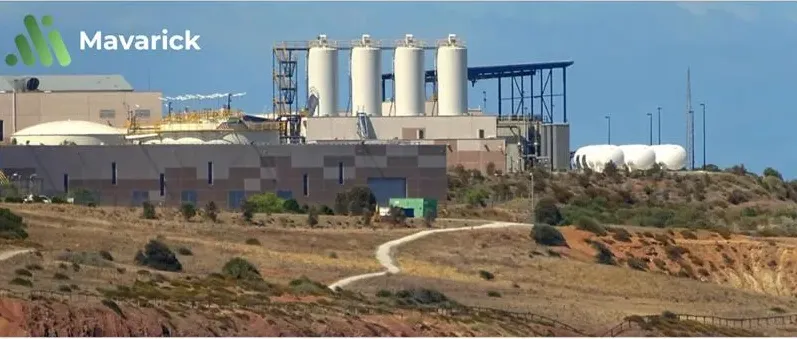
Table of Contents
- What is Science-Based Targets?
- Why Are Science-Based Targets Critical for Businesses Today?
- 1. Meeting Regulatory Expectations
- 2. Enhancing Competitiveness
- 3. Driving Innovation
- 4. Securing Long-Term Resilience
- The Challenges of Setting Science-Based Targets
- Mavarick: Turning Targets into Tangible Results
- 1. Automated and Accurate Data Collection
- 2. Streamlined Regulatory Reporting
- 3. Actionable Recommendations for Emissions Reduction
- 4. Supplier Engagement and Collaboration
- 5. Real-Time Progress Tracking
- Why Choose Us?
- Conclusion: From Ambition to Action
Have you ever wondered how businesses can contribute meaningfully to the fight against climate change? While pledges and commitments are critical first steps, the real impact lies in measuring emissions and setting actionable goals. This is where Science-Based Targets (SBTs) step in—a target setting standard that goes beyond generic promises to deliver climate action rooted in science.
With industries, particularly manufacturing, responsible for a considerable chunk of global greenhouse gas (GHG) emissions, science-based targets provide companies with the clarity and direction needed to reduce their environmental impact.
But what exactly are these targets, and how can businesses align with them?
Let us start with the basics first!

What is Science-Based Targets?
At their core, science-based targets are specific and measurable GHG emission reduction goals aligned with the latest climate science. Their purpose is simple yet profound: to limit global temperature rise to well below 2°C, ideally 1.5°C, compared to pre-industrial levels, as outlined in the Paris Agreement.
The Science-Based Targets initiative (SBTi) provides companies with the frameworks and methodologies needed to align their goals with these global climate imperatives. Unlike traditional sustainability metrics, SBTs offer a science-driven approach to reducing emissions across the value chain, including:
- Scope 1: Direct emissions from company-owned facilities and vehicles.
- Scope 2: Indirect emissions from purchased electricity, steam, and heating.
- Scope 3: Indirect emissions from the supply chain, product lifecycle, and more.
Did you know that Scope 3 emissions often account for more than 70% of a company’s total carbon footprint, especially in manufacturing? This makes tackling supply chain emissions a critical part of any sustainability strategy. Read our blog on scope 3 emissions to know more.

Why Are Science-Based Targets Critical for Businesses Today?
1. Meeting Regulatory Expectations
Governments worldwide are rolling out stricter climate regulations, such as the European Union’s Corporate Sustainability Reporting Directive (CSRD) and other frameworks. Science-based targets ensure compliance and keep businesses ahead of regulatory shifts. Curious about how the CSRD impacts carbon accounting and reporting? Read our blog on Carbon Accounting Software and CSRD to explore how businesses can stay ahead of these shifts with the right tools and strategies.
2. Enhancing Competitiveness
Consumers, investors, and stakeholders are increasingly favouring companies with robust sustainability goals. By aligning with SBTs, businesses can differentiate themselves in competitive markets.
3. Driving Innovation
The pursuit of ambitious targets often leads to innovation—whether it is adopting cleaner technologies, improving energy efficiency, or developing greener products.
4. Securing Long-Term Resilience
A focus on sustainability reduces exposure to climate risks, such as volatile energy prices or supply chain disruptions.

The Challenges of Setting Science-Based Targets
While the benefits are clear, setting and acting toward reaching SBTs is no small feat. Many companies encounter significant hurdles along the way:
- Data Quality and Accuracy: Gathering reliable emissions data—especially from Scope 3 activities—can be a daunting task, given the complexity of supply chains.
- Regulatory Complexity: Navigating a constantly evolving landscape of local, national, and international regulations adds another layer of difficulty.
- Cost Implications: Transitioning to sustainable practices often requires substantial upfront investments in renewable energy, energy-efficient equipment, and technology upgrades.
- Accessibility for SMEs: Small and medium-sized enterprises often lack the resources or expertise needed to set and achieve SBTs.
Have you faced similar challenges in aligning your business goals with climate science? If so, you are not alone—many organisations struggle with these barriers. But there is a way forward.

Mavarick: Turning Targets into Tangible Results
Turning science-based targets into actionable outcomes is where businesses need the right tools and support. This is where Mavarick comes in, offering a seamless way to navigate the complexities of SBT setting and implementation.
But how does Mavarick help businesses overcome these pain points while achieving their sustainability goals?
You can set your SBT using Mavarick’s platform. Instead of diving into the detailed SBT methodology, our Target Setting Tool is already aligned with it.
According to the methodology, for example, companies must set a near-term target that should be achieved in 5 to 10 years of the submission year. Our platform will automatically show you options within this range only. And this is applicable for many other requirements too.
At Mavarick, we specialise in helping organisations move from ambition to action. Our AI-driven ESG platform simplifies every stage of the journey, from collecting and managing sustainability data to setting SBTs and tracking progress and ensuring compliance.
Mavarick offers a range of features that directly support businesses in achieving their science-based targets (SBTs) by addressing key challenges and streamlining the implementation process. Here’s how Mavarick’s platform contributes to the journey:
1. Automated and Accurate Data Collection
Challenge: Collecting reliable and comprehensive emissions data is one of the most critical steps in setting and tracking SBTs, especially across Scope 3 emissions.
Mavarick’s Solution:
- Centralised Platform: Mavarick’s platform integrates data from multiple sources, including operational systems, suppliers, and third-party databases, to provide a complete and accurate picture of emissions across Scopes 1, 2, and 3.
- How it supports you on setting a SBT: Your SBT must cover 98% of scopes 1 and 2 combined, and you must set a scope 3 target if it represents more than 67% of your total emissions. Mavarick’s platform will automatically retrieve your baseline and full GHG inventory to set a SBT within the requirements.
2. Streamlined Regulatory Reporting
Challenge: Setting an SBT while guaranteeing compliance with evolving frameworks like CSRD, SECR, and the GHG Protocol can be time and resource intensive.
Mavarick’s Solution:
- Regulatory Framework Alignment: Mavarick’s software automates compliance reporting, aligning with multiple global frameworks, including the EU’s CSRD and Science-Based Targets initiative (SBTi) guidelines.
3. Actionable Recommendations for Emissions Reduction
Challenge: Knowing what actions to take to reduce emissions and meet targets can be overwhelming without a clear roadmap.
Mavarick’s Solution:
- AI-Powered Insights: Mavarick’s platform analyses emissions data and provides actionable recommendations tailored to the company’s operations, such as:
- Transitioning to renewable energy sources.
- Optimising energy efficiency in manufacturing processes.
- Enhancing supply chain sustainability.
- Customised Strategies: Industry-specific insights help businesses prioritise high-impact actions.
4. Supplier Engagement and Collaboration
Challenge: Uncertainty related to setting a Scope 3 target since Scope 3 emissions, particularly from supply chains, require supplier engagement.
Mavarick’s Solution:
- Supplier Engagement Tools: The platform provides functionalities to collaborate with suppliers, gather emissions data, and align on sustainability goals.
- Performance Tracking: Regular updates from suppliers are integrated into the platform, ensuring progress is continuously monitored.
5. Real-Time Progress Tracking
Challenge: Businesses need to regularly track and assess progress toward their SBTs to ensure alignment and adjust strategies.
Mavarick’s Solution:
- Dynamic Dashboards: Real-time dashboards provide visualisations of key metrics, including emissions reductions, energy usage, and target progress.
- Scenario Analysis: Companies can evaluate different pathways to achieve SBTs, weighing costs, timelines, and impact.
By combining these features, Mavarick empowers organisations to overcome the complexities of setting, tracking, and achieving science-based targets while maximising efficiency and minimising resource strain. Whether your focus is on reducing emissions, meeting compliance requirements, or driving long-term sustainability, Mavarick provides the tools and insights to make it happen.
Why Choose Us?
- Supports complex supply chains. Learn more about supplier engagement and emissions tracking.
- Automates data management and regulatory compliance to save time and effort. Explore how automation supports compliance.
- AI-driven insights to turn data into actionable strategies
- Offers integrated and scalable solutions
Would you like to see how our platform can simplify your journey toward achieving science-based targets? Explore our solutions for more information.
Conclusion: From Ambition to Action
Aligning with science-based targets is no longer just a moral responsibility—it is a business imperative. While the journey may seem daunting, the right tools and strategies can turn even the most complex challenges into opportunities for growth and innovation.
With Mavarick as your partner, achieving your sustainability goals becomes simpler, faster, and more effective. Let us turn your climate ambitions into measurable actions that benefit your business and the planet.
Ready to take the next step? Contact Mavarick today to discover how we can help you align with science-based targets and achieve your sustainability goals.
Carbon Accounting System
Carbon Emissions Reporting for the Supply Chain
- Visible Supply Chain
- Quality Data You can Trust
- Auditable Reports

